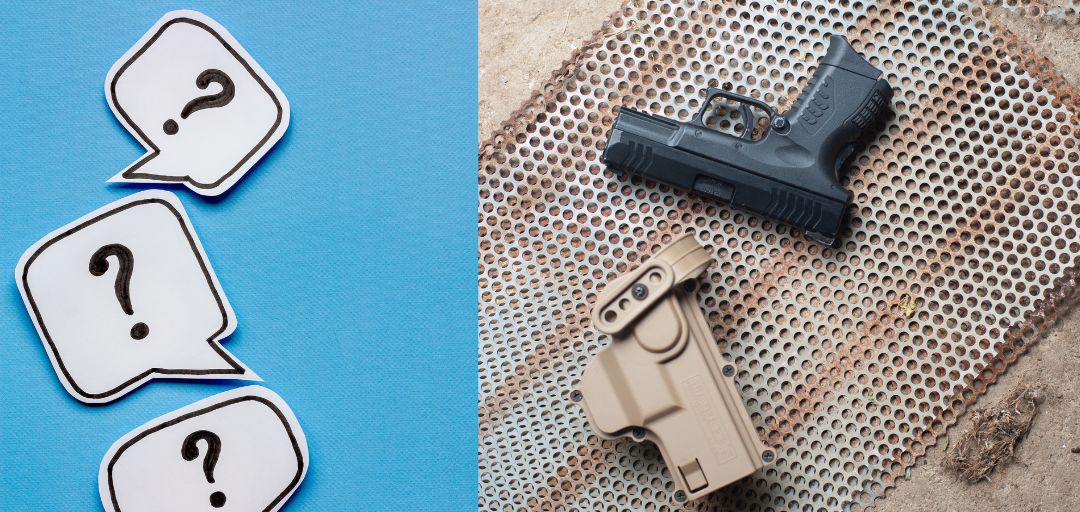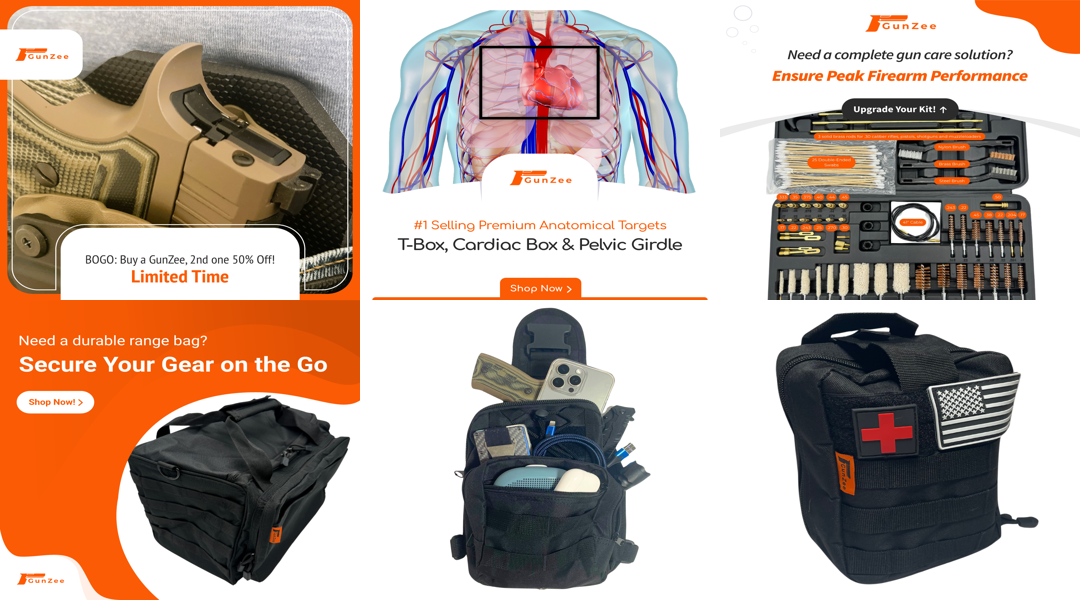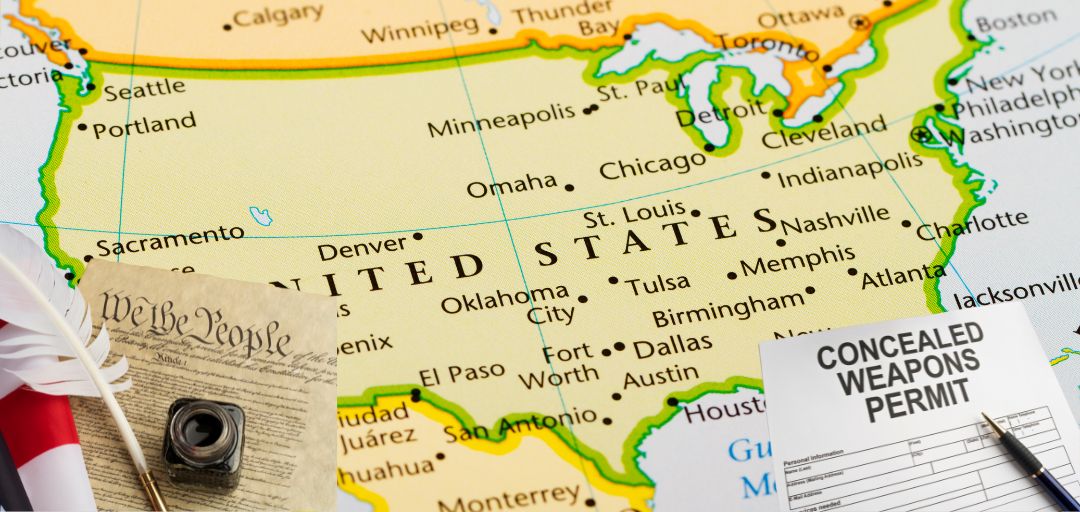Concealed carry can be complex and intimidating, especially for those new to it. With regulations, techniques, and gear considerations involved, it’s common to have a lot of questions. In this guide, we’ll answer some of the most frequently asked questions about concealed carry, providing essential insights to help you carry safely, responsibly, and comfortably.
1. What is Concealed Carry?
Concealed carry refers to the practice of carrying a firearm or weapon in a way that is hidden from public view, usually on one’s person. The main objective is to be able to access the firearm if needed for self-defense without openly displaying it. Concealed carry is regulated differently by each state in the U.S., so it’s important to understand the rules where you live and travel.
For an introduction to concealed carry, check out our article on Developing a Concealed Carry Mindset.
2. Do I Need a Permit to Carry Concealed?
Permit requirements vary widely by state. Some states require a permit to carry concealed, while others allow permitless carry, also known as constitutional carry, for lawful gun owners. It’s essential to check your state’s laws to understand whether a permit is required and what the application process involves.
For state-specific concealed carry laws and reciprocity information, visit the USCCA’s guide: https://www.usconcealedcarry.com/resources/ccw_reciprocity_map/.
3. How Do I Obtain a Concealed Carry Permit?
If your state requires a permit, the process usually involves:
- Completing a Firearm Safety Course: Most states require a training course that covers gun safety and sometimes includes live-fire training.
- Background Check: A criminal background check is typically required.
- Application Submission: This may include fingerprinting, submitting proof of residency, and paying application fees.
Your local law enforcement agency or state government website usually provides details on the specific process.
4. Where Am I Legally Allowed to Carry Concealed?
Laws differ by state, but common areas where firearms are often restricted include:
- Schools and Educational Institutions
- Government Buildings (e.g., courthouses)
- Airports (in secure areas)
- Private Properties with "No Firearms" Signs
Some states enforce these "no-carry" signs, while others do not. Make sure you know the restrictions in your state.
For more on navigating gun-free zones, read our article: Concealed Carry and Gun-Free Zones.
5. What Kind of Firearm Should I Use for Concealed Carry?
Choosing the right firearm depends on your comfort level, skill, and how you intend to carry. Here are a few popular options:
- Sig Sauer P365 Series: Known for high capacity in a small frame.
- Springfield Hellcat: Offers similar compactness and capacity.
- Glock 43X: Known for reliability and simplicity.
6. What Type of Holster is Best for Concealed Carry?
A good holster is critical for comfort, safety, and effective concealment. When selecting a holster, look for these qualities:
- Comfort: A holster that doesn’t dig into your body during movement.
- Retention: Ensures that your firearm stays securely in place.
- Concealment: Minimizes printing, which is when the outline of the firearm shows through clothing.
For added comfort, consider adding a GunZee Holster Pad to your setup. This 3-layer memory foam pad reduces pressure points and helps avoid discomfort from hard edges. You can learn more here: GunZee Holster Pad.
7. How Should I Practice Concealed Carry?
Regular practice is essential for effective concealed carry. Here’s how to get started:
- Range Practice: Visit a shooting range regularly to maintain shooting skills.
- Drawing Drills: Practice drawing from concealment to improve speed and safety.
- Realistic Targets: Using realistic targets, like GunZee’s Anatomical Targets, helps you aim at critical zones, enhancing accuracy in high-stakes scenarios. Learn more about Anatomical Targets here.
For a detailed training regimen, read our guide on Builidng an Effective Training Regimen.
8. What Should I Do If I’m Pulled Over While Carrying?
If you’re pulled over by law enforcement while carrying concealed, here’s a general guideline:
- Stay Calm: Keep your hands visible and don’t make sudden movements.
- Inform the Officer: In some states, you’re legally required to inform the officer that you’re carrying. Even if it’s not required, disclosing is often a good idea.
- Follow Instructions: Listen to the officer’s requests and comply respectfully.
For state-specific details, check out our article: What Should I Do If I'm Pulled Over While Carrying.
9. Can I Carry Across State Lines?
If you’re traveling, it’s essential to know which states honor your concealed carry permit. Some states have reciprocity agreements that allow you to carry legally across state lines, while others do not. Always check reciprocity maps before traveling.
For an up-to-date reciprocity guide, visit the USCCA’s resource: https://www.usconcealedcarry.com/resources/ccw_reciprocity_map/.
10. What Should I Do in an Active Shooter Situation?
In an active shooter scenario, prioritize Run, Hide, Fight:
- Run if there’s a clear and safe exit.
- Hide if you cannot run. Find cover and silence your phone.
- Fight only if your life is directly threatened and there’s no other option.
If you carry a firearm, remember to assess your environment and ensure you only draw your weapon if absolutely necessary and legal to do so.
11. How Often Should I Practice?
Practice frequency depends on your comfort and skill level, but a good rule of thumb is to visit the range at least once a month. Supplement range practice with dry-fire drills at home to build muscle memory and confidence.
For a step-by-step concealed carry training routine, visit: Builidng an Effective Training Regimen
12. What Legal Consequences Could I Face After Using a Firearm in Self-Defense?
Even in cases of clear self-defense, discharging a firearm can have legal consequences. Potential outcomes include:
- Police Investigation: Each use of deadly force will be investigated.
- Criminal Charges: Depending on the situation, you may face criminal charges.
- Civil Lawsuits: The attacker or their family could sue you.
Consider legal defense options like self-defense insurance. Learn more here: https://www.usconcealedcarry.com/about/press-room/uscca-announces-major-evolution-of-industry-leading-self-defense-liability-insurance-member-benefit-to-further-prepare-responsibly-armed-americans/.
13. Should I Carry with a Round Chambered?
Carrying with a round in the chamber means the firearm is immediately ready to fire upon drawing. This is a personal choice and depends on your comfort, experience, and training. While chambered carry provides a faster response time, it requires careful training and discipline.
Read more about this decision in our article on Essentials of Concealed Carry.
14. What is Printing and How Can I Avoid It?
Printing is when the outline of your concealed firearm shows through your clothing, potentially drawing unwanted attention. Here are ways to avoid it:
- Wear Looser Clothing: Baggy or layered clothing helps hide outlines.
- Use a Quality Holster: A holster like the GunZee Holster Pad can help keep your firearm close to your body. Shop GunZee Holster pads.
- Experiment with Carry Positions: Appendix carry, IWB, and other positions may help minimize printing based on your body type and clothing style.
Conclusion: Empower Yourself with Knowledge
Concealed carry comes with many questions and responsibilities, but staying informed can make all the difference. By understanding the laws, selecting the right gear, and regularly training, you can carry responsibly and confidently. For additional resources and guides, explore our blog at GoGunZee.com/blogs/ccw for more in-depth concealed carry advice.



